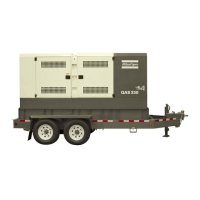- 38 -
Connecting the generator
Precautions for non-linear and sensitive
loads
The most common non-linear, 3-phase loads are thyristor/
rectifier-controlled loads, such as convertors supplying
voltage to variable speed motors, uninterruptable power
supplies and Telecom supplies. Gas-discharge lighting
arranged in single-phase circuits generate high 3rd
harmonics and risk for excessive neutral current.
Loads most sensitive to voltage distortion include
incandescent lamps, discharge lamps, computers, X-ray
equipment, audio amplifiers and elevators.
Consult Atlas Copco for measures against the adverse
influence of non-linear loads.
Quality, minimum section and maximum
length of cables
The cable connected to the terminal board of the generator
must be selected in accordance with local legislation. The
type of cable, its rated voltage and current carrying
capacity are determined by installation conditions, stress
and ambient temperature. For flexible wiring, rubber-
sheathed, flexible core conductors of the type H07 RN-F
(Cenelec HD.22) or better must be used.
The following table indicates the maximum allowable 3-
phase currents (in A), in an ambient temperature of 40°C,
for cable types (multiple and single core PVC insulated
conductors and H07 RN-F multiple core conductors) and
wire sections as listed, in accordance with VDE 0298
installation method C3. Local regulations remain
applicable if they are stricter than those proposed below.
The lowest acceptable wire section and the corresponding
maximum cable or conductor length for multiple core
cable or H07 RN-F, at rated current, for a voltage drop e
lower than 5% and at a power factor of 0.80, are
respectively 2.5 mm² and 144 m. In case electric motors
must be started, oversizing the cable is advisable.
The voltage drop across a cable can be determined as
follows:
e = Voltage drop (V)
I = Rated current (A)
L = Length of conductors (m)
R = Resistance (/km to VDE 0102)
X = Reactance (/km to VDE 0102)
Connecting the load
Site distribution panel
If outlet sockets are provided, they must be mounted on a
site distribution panel supplied from the terminal board of
the generator and in compliance with local regulations for
power installations on building sites.
Protection
– Check whether frequency, voltage and current comply
with the ratings of the generator.
– Provide for the load cable, without excessive length, and
lay it out in a safe way without forming coils.
– Open the door of the control and indicator panel and the
transparent door in front of the terminal board X1.
– Provide the wire ends with cable lugs suited for the cable
terminals.
– Loosen the cable clamp and push the wire ends of the load
cable through the orifice and clamp.
– Connect the wires to the proper terminals (L1, L2, L3, N
and PE) of X1 and tighten the bolts securely.
– Tighten the cable clamp.
– Close the transparent door in front of X1.
Non-linear loads draw currents with high
contents in harmonics, causing distortion
in the wave form of the voltage generated
by the alternator.
Wire section Max. current (A)
(mm
²
)
Multiple core Single core H07 RN-F
25 94 101 88
35 114 123 110
50 138 155 138
70 176 191 170
95 212 228 205
120 245 273 239
150 282 314 250
185 323 358 313
240 379 421 371
300 429 477 428
Wire section Max. current (A)
(mm
²
)
Multiple core Single core H07 RN-F

